Under Construction 
Contents: Basics | Squirrel-Proofing | Types of food | Placement
Bird Feeding Basics:
- Variety of quality seed.
- Fresh water for drinking and bathing.
- Ample cover, preferably provided by native plants. Native plants also provide potential nesting sites and a source of natural food.
Bird Feeding Basics at Audubon
Squirrel-Proofing Your Bird Feeders:
Food:
- Woodpeckers love suet
- Chickadees and Titmice will eat almost anything from any feeder
- Finches prefer sunflower seed from a hopper, tube or platform feeder and
Nyjer® (thistle) from a tube
- Cardinals love sunflower and safflower from a hopper, tube or platform feeder
- Wrens will eat suet when the mood strikes them
- Mourning Doves will eat safflower, thistle or sunflower from a hopper or platform feeder or scattered on the patio
- American Goldfinches will eat thistle or hulled sunflower seed from a tube or window feeder.
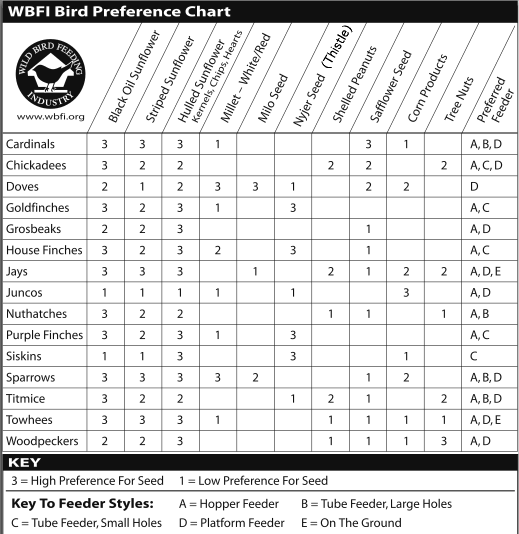
Source: Wild Bird Feeding Industry (WBFI) - Chart
Milo is the commercial name for sorghum. Millet is a variety of grains from small-seeded grasses, Nyjer® is thistle.
 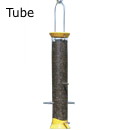 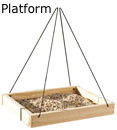 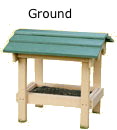
| Food | Feeder | Birds |
| Nyjer® (Thistle), millet and sunflower chips | small hole or mesh tube feeder. | Finches, Chickadees and Titmice |
| sunflower and safflower seeds | large port tube feeder | Cardinals, Grosbeaks, Jays, Junco, Indigo Bunting, Mourning Doves |
Birds that prefer sunflower seed will just empty a tube feeder to get at the sunflower seeds, throwing the other seed types in the mix on the ground. It is best to offer one type of seed in a tube feeder.
See: Tube Bird Feeders
How To Attract the Seven Most Desired Wild Birds
Small Songbirds - finches, chickadees, titmice, pine siskins, ...
Larger birds - Cardinals, Doves, Jays
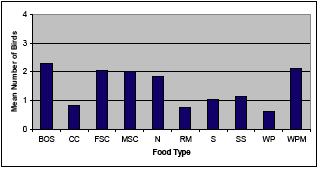 Food Preference from Project Wildbird:
Food Preference from Project Wildbird:
Black Oil Sunflower (BOS), Cracked Corn (CC)
, Fine Sunflower Chips (FSC), Medium Sunflower Chips (MSC)
, Nyjer® (N), Red Milo (RM)
, Safflower (S), Striped Sunflower (SS)
, Whole Peanuts (WP), White Proso Millet (WPM)
| |
MOST PREFERRED FOOD TYPE |
| SPECIES |
 |
 |
 |
 |
 |
 |
 |
 |
 |
 |
 |
 |
 |
 |
| Bluebirds |
|
|
|
|
|
|
|
|
|
|
✓ |
|
|
|
| Bushtits |
|
|
|
|
|
|
|
✓ |
|
✓ |
|
✓ |
|
|
| Cardinals |
✓ |
|
✓ |
|
|
|
|
|
|
|
|
✓ |
|
|
| Chickadees |
✓ |
|
|
|
|
|
|
|
|
✓ |
|
|
|
|
| Doves |
|
|
✓ |
|
✓ |
|
|
|
|
|
|
|
|
|
| Finches |
✓ |
✓ |
|
|
|
✓ |
|
|
|
|
|
|
|
|
| Flickers |
|
|
|
✓ |
|
|
|
✓ |
|
✓ |
|
|
|
|
| Goldfinches |
|
|
|
✓ |
|
✓ |
|
|
|
|
|
|
|
|
| Grosbeaks |
✓ |
✓ |
|
|
|
|
|
|
|
|
|
|
|
|
| Hummingbirds |
|
|
|
|
|
|
|
|
|
|
|
|
|
✓ |
| Jays |
|
|
|
|
|
|
|
✓ |
✓ |
|
|
|
|
|
| Juncos |
|
|
|
|
✓ |
|
✓ |
|
|
|
|
|
|
|
| Kinglets |
|
|
|
|
|
|
|
|
|
✓ |
|
✓ |
|
|
| Nuthatches |
✓ |
|
|
|
|
|
|
|
✓ |
✓ |
|
|
|
|
| Orioles |
|
|
|
|
|
|
|
|
|
|
|
|
✓ |
✓ |
| Siskin, Pine |
|
|
|
✓ |
|
✓ |
|
|
|
|
|
|
|
|
| Sparrows |
|
|
|
|
✓ |
|
|
|
|
|
|
|
|
|
| Titmouse |
✓ |
|
|
|
|
|
|
|
|
|
|
|
|
|
| Towhees |
|
|
|
|
✓ |
|
|
|
|
|
|
|
|
|
| Woodpeckers |
✓ |
|
|
|
|
|
|
|
✓ |
✓ |
|
✓ |
|
|
| Wrens |
|
|
|
|
|
|
|
|
|
✓ |
✓ |
✓ |
|
|
| Number |
7 |
2 |
2 |
3 |
4 |
3 |
1 |
3 |
3 |
5 |
2 |
5 |
1 |
2 |
Most Preferred
Food Type |
 |
 |
 |
 |
 |
 |
 |
 |
 |
 |
 |
 |
 |
 |
See: Wild Bird Seed Comparison Chart at Doctors Foster and Smith for specific food and feeder recommendations.
Avoid budget seed mixtures from grocery stores. They contain fillers birds won't eat.
Black oil Sunflower is the best seed with 21% fat and 14% protein, coupled with a relatively thin shell. A good mix will have 50% of black oil.
Selecting Seeds at Audubon
Homemade Bird Treats
Homemade Suet:
Suet is raw beef or mutton fat. Often it is the hard fat found around the loins and kidneys, and is about 94% fat, largely saturated fat. You should note that it melts at about 21¡C (70¡F).
To make bird food, the suet is usually prepared in a block about the size of a tupperware sandwich container, and most of the time as it cools and thickens, other ingredients like chopped peanuts, sunflower seeds, and bird seed is added. This results in a block of high energy food that will survive well in the wintertime. Above 70 F it can become rancid as the suet starts to melt.
- Melt 1 cup shortening (or lard or fresh ground suet) in a saucepan on very low heat.
- Add 1 cup peanut butter and stir until melted.
- To this add 1 cup plain flour
- 3 cups plain cornmeal. Mix thoroughly.
- 1/4 to 1/2 cup birdseed or sunflower chips
- 1/4 to 1/2 cup raisins
- The final consistency will be putty-like.
- Pour into a disposable 8 inch by 8 inch aluminum pan and allow to cool.
- Slice into quarters; each one should fit nicely into a suet cage, available at most garden centers.
- Store remaining squares in the refrigerator.
How to Make Homemade Bird Suet at WalterReeves.com/
Suet Recipes at BaltimoreBirdClub.org
Stores:
Agway
Wild Birds Unlimited
Petco
Wild Bird Habitat Store
Backyard Wild Birds - Quality Bird Feeding Solutions
BestNest.com
Links:
Bird Feeder Placement
Bird Watching in hobbies
Bird Feeding Basics at Audubon
† The Autum/Winter 2008-09 New Jersey Audubon magazine is devoted to bird feeding.
Project Wildbird
Wild Bird Feeding Industry (WBFI)
Backyard-Birdz.com
Bird pictures:
NJ Bird Photos: Birds of New Jersey:
Ecobirder
FeedingBirdsInYourYard.blogspot.com
Birds at BeGardenChic.comx
Feeders:
See Stores and links above also.
The Zen Birdfeeder at WildBirdsUnlimited
Creating a Backyard Bird Habitat: 4 Basic Steps to Attracting Avian Visitors | Suite101.com
Feeding Birds at WildBirdGuide.com
Suet Bird Feeders (work well in Winter)
www.bird-house-bath.com
www.birdWatchersDigest.com
Bird Watching
Squirrel Proofing:
Anti-Squirrel Safeguards at Audubon
Squirrel-resistant bird feeder from Chickadee Farm
Squirrel Proof Bird Feeders
Squirrel-Proof Bird Feeders - defend your bird feeders against squirrels
Stokes Tips - Squirrel-Proofing Your Bird Feeders at agway.com
Baffle-Style Squirrel Proof Bird Feeders
Squirrel examples
Erva Cylinder Squirrel Baffle (For 4 X 4 Wood Posts)
Other:
Bird control products at AbsoluteBirdControl
last updated 12 Sept 2008
|
 Home & Garden
Home & Garden
 Bird Feeders
Contact
Bird Feeders
Contact
 Home & Garden
Home & Garden
 Bird Feeders
Contact
Bird Feeders
Contact





